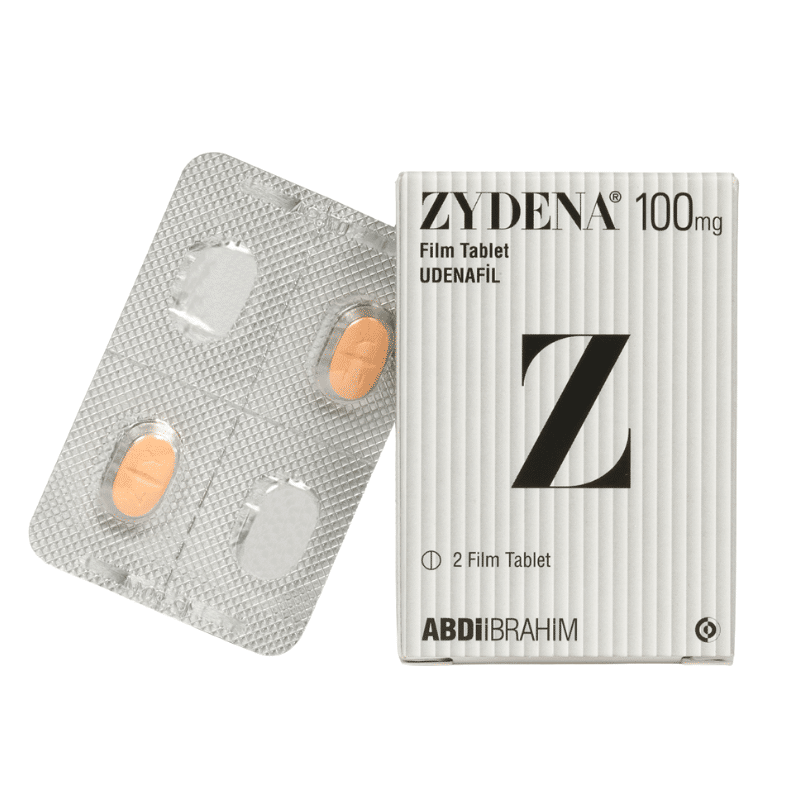Does Kratom Interact With Udenafil (Zydena)?
There’s a low to medium risk of mixing kratom and PDE5 inhibitors like udenafil. These drugs treat erectile dysfunction and possess no psychoactive properties.
Kratom and udenafil do not cause similar physical effects, but their metabolic processes overlap. Udenafil is mainly broken down and metabolized in the liver by the cytochrome CYP3A4 enzyme [1]. This is significant, as kratom also requires the CYP3A4 enzyme for proper metabolism. Other studies have also shown that mitragynine —an active alkaloid found in kratom —can act as a CYP3A4 inhibitor [2, 3].
In other words, kratom can slow down udenafil’s metabolization, increasing the risk of experiencing side effects. PDE5 inhibitors enhance the ability of arteries; slowed metabolization can lead to an increased amount of udenafil and could cause damage to the arterial system.
Udenafil Specs

| Drug Name | Udenafil |
| Trade Name | Zydena |
| Classification | PDE5 Inhibitor |
| CYP Metabolism | CYP3A4 and CYP3A5 |
| Interaction With Kratom | Metabolic Inhibition |
| Risk of Interaction | Low |
Is it Safe to Take Kratom With Udenafil (Zydena)?
While the risk is relatively low, there’s still the potential for an adverse reaction. It’s best to avoid mixing these two unless you talk to your doctor first.
Kratom’s inhibitory effect on udenafil’s metabolism can mean that the drug takes longer to clear from the body. If you’re taking udenafil daily, this could cause a slow but constant buildup in the bloodstream.
This accumulation increases the risk of adverse effects and may cause toxicity. Be sure to talk to your doctor, and limit your kratom intake if you use udenafil daily.
What is Udenafil?
Udenafil — sold under the trade name Zydena — is used to treat erectile dysfunction. Like other drugs used to treat this condition, the compound is classified as a PDE5 inhibitor [4].
Udenafil is fast-acting; peak plasma concentrations in the bloodstream peak in 1 to 1.5 hours. Additionally, it also has a long half-life of 11 to 13 hours.
It is important to note that udenafil is not yet FDA-approved in the United States, although phase II trials are underway. Udenafil is available in Korea, Russia, and the Philippines.

What is Udenafil Used for?
Udenafil is used to treat erectile dysfunction (ED).
The pharmacokinetics of udenafil allows users to take a once-daily dosage at a time of their choosing [4].
It can also be taken on demand. However, couples often find that taking the drug on demand reduces sexual spontaneity.
Currently, the only daily-dose, FDA-approved treatment for erectile dysfunction is tadalafil (Cialis). This is problematic for some who cannot tolerate the drug due to phosphodiesterase subtype selectivity.
At the moment, there are four other PDE5 inhibitors used to treat erectile dysfunction: sildenafil (Viagra), vardenafil (Levitra), tadalafil (Cialis), and avanafil (Stendra).
If you’re looking to treat your erectile dysfunction, be sure to consult with your physician to determine what will work best for your sexual habits and preferences.
What’s the Dose of Udenafil?
The appropriate dosage of udenafil will always depend on the patient.
Udenafil doses range from 50 mg to 100 mg or even 200 mg, depending on their dosing regimen (daily or on-demand) and what works best for the individual.
One study found that udenafil improved ED symptoms when administered in doses of 50 or 75 mg daily for twelve weeks [5].
We must also remember that udenafil is still undergoing clinical trials in the US. If you’re planning on using udenafil, consult your doctor on what dosage is appropriate for you.
Generic & Brand Name Versions
Udenafil was developed by Dong-A Pharmaceutical and is sold under the trade name Zydena.

What Are the Side Effects of Udenafil?
Studies show the main adverse effects resulting from udenafil were headaches and flushing. Thankfully, these were classified as transient and mild [6].
The following side effects are also common:
- Coughing
- Diarrhea
- Dizziness
- Heartburn
- Increased sensitivity to light
- Nasal congestion
- Nausea
What is Kratom?
Kratom (Mitragyna speciosa) is a herbal extract that contains a wide array of plant-based alkaloids with plenty of beneficial health properties.
Alkaloids are natural compounds in many types of living organisms. By interacting with the opioid receptors, they can cause powerful reactions within the body.
The main alkaloids in kratom are mitragynine and 7-hydroxymitragynine these account for the many benefits that kratom provides.
The Mitragyna speciosa tree grows abundantly in countries like Vietnam, Thailand, and Indonesia. People there have used the herb for centuries as a traditional medicine to combat fatigue and relieve pain.
There are many ways to take kratom, from tinctures to powder, kratom capsules, and teas. Its popularity in the United States is snowballing.

What is Kratom Used for?
Kratom has many traditional uses, including pain relief and muscle relaxation. However, there are other modern and common uses for kratom, including:
- Arthritis pain
- Benzodiazepine withdrawal syndrome
- Chemotherapy-related pain
- Chronic back pain
- Depression
- Fibromyalgia
- Migraines
- Nerve pain
- Psoriatic arthritis
When administered in low doses, kratom can stimulate the mind and produce valuable benefits. For instance, it can increase energy, like coffee, only without the jitters. It can also create the opposite effect and promotes sleep (in larger doses).
It also has mood-enhancing properties, making it popular among those that deal with depression.
When it comes to the medical benefits, kratom doesn’t disappoint either. Kratom also has potent analgesic and anxiolytic (anti-anxiety) benefits.
As if that weren’t enough, kratom has shown promise as a weight-loss supplement and treating the symptoms stemming from withdrawal symptoms.
What’s the Dose of Kratom?
As with most other drugs, proper dosage recommendations vary according to several factors, such as total body mass and method of consumption. However, there are dose recommendations that act as a guide.
- Low dose (1-5 g) — for stimulating and nootropic effects
- Medium dose (5-10 g) — for analgesic and anxiolytic effects
- High dose (10-15 g) — very potent; for sleep and pain relief; not recommended for inexperienced users.
If you’re new to kratom, it’s best to go slow and see how your body reacts. You might have a sensitivity to it. In any case, first-timers should never exceed 5 grams.
Related: How Long Should I Wait Between Kratom Doses?

What Are the Side Effects of Kratom?
There are a few side effects from kratom that most often come with higher doses. These are avoidable if you stick to smaller amounts, though some people may still experience them.
The side effects of kratom are:
- Addiction & dependence
- Anxiety or restlessness
- Constipation
- Diarrhea
- Dizziness
- Depression
- Frequent urination
- Headaches
- Heart palpitations
- Nausea and vomiting
- Numbness
- Sedation and prolonged sleepiness
Other, less common, side effects include:
- High blood pressure
- Hyperpigmentation
- Itchiness in the skin
- Liver damage (with long-term use)
- Low libido
- Loss of muscle coordination
- Poor appetite
- Seizures
- The Wobbles
- Tremors or muscle contractions
- Withdrawal symptoms
Thankfully, kratom’s side effects are mild.
If side effects become too pervasive, it’s time to scale back kratom consumption considerably.
Lastly, since kratom is unregulated, buying from untrustworthy kratom sellers can put you at risk of exposure to contaminants, one of the most significant risks of using kratom.
Always buy your kratom from a trustworthy source.
What Are the Different Types of Kratom?
There are several different types of kratom, which are often referred to as “strains.” These strains are usually named after the region in which they are grown and the color of the leaves veins.
The four main strains of kratom are:

White Vein Kratom
White vein kratom is a mind-based strain and excels at producing nootropic benefits. They’re the perfect way to add a punch to your morning.

Red Vein Kratom
The red-veined kratom strains are the go-to choice for people dealing with chronic pain or those who want to treat their anxiety but don’t want to resort to prescription medications.
Red vein kratom is an excellent choice for these two options as it is the most analgesic and anxiolytic strain, excellent for those who don’t want to consume too much kratom but want pain relief.

Green Vein Kratom
Green vein kratom sits right between white and red in the kratom spectrum.
They have a balanced alkaloid profile with analgesic and anxiolytic properties and mind-based effects.
However, this means that you won’t experience the targeted nature of a white or red kratom strain.

Yellow Vein Kratom
Yellow vein kratom is the odd man out. It doesn’t really have any distinguishing characteristics except that it is usually considered a milder strain and similar to green strains.
If you happen to have a sensitivity to kratom, then the yellow-veined strains are your best option.

Key Takeaways: Is it Safe to Mix Kratom & Udenafil (Zydena)?
Simply said: it’s likely safe, but there’s still a chance there could be problems because of how these two are metabolized. It’s best to talk to your doctor before combining them.
If you take udenafil on-demand or in low doses, there’s likely little to worry about. However, if you take udenafil daily, you will probably want to regulate your kratom consumption.
To be safe, alert your physician about this combination, and always consume kratom in responsible dosages.
- Ku, H. Y., Ahn, H. J., Seo, K. A., Kim, H., Oh, M., Bae, S. K., … & Liu, K. H. (2008). The contributions of cytochromes P450 3A4 and 3A5 to the metabolism of the phosphodiesterase type 5 inhibitors sildenafil, udenafil, and vardenafil. Drug Metabolism and Disposition, 36(6), 986-990.
- Hanapi, N. A., Ismail, S., & Mansor, S. M. (2013). Inhibitory effect of mitragynine on human cytochrome P450 enzyme activities. Pharmacognosy research, 5(4), 241.
- Kamble, S. H., Sharma, A., King, T. I., León, F., McCurdy, C. R., & Avery, B. A. (2019). Metabolite profiling and identification of enzymes responsible for the metabolism of mitragynine, the major alkaloid of Mitragyna speciosa (kratom). Xenobiotica, 49(11), 1279-1288.
- Kang, S. G., & Kim, J. J. (2013). Udenafil: efficacy and tolerability in the management of erectile dysfunction. Therapeutic advances in urology, 5(2), 101-110.
- Zhao, C., Kim, S. W., Yang, D. Y., Kim, J. J., Park, N. C., Lee, S. W., … & Park, J. K. (2011). Efficacy and safety of once-daily dosing of udenafil in the treatment of erectile dysfunction: results of a multicenter, randomized, double-blind, placebo-controlled trial. European urology, 60(2), 380-387.
- Paick, J. S., Kim, S. W., Park, Y. K., Hyun, J. S., Park, N. C., Lee, S. W., … & Chung, W. S. (2009). ED PHARMACOTHERAPY: The Efficacy and Safety of Udenafil [Zydena] for the Treatment of Erectile Dysfunction in Hypertensive Men Taking Concomitant Antihypertensive Agents. The journal of sexual medicine, 6(11), 3166-3176.










